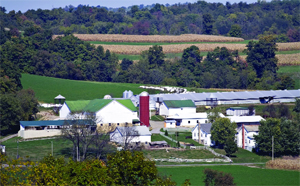
Farm Succession: Do you have the right plan?
By Peter van Dongen P.Ag
Features Business & Policy Farm BusinessDo you have the right plan?
If you own a farm today, you live with this simple truth: one day it
will no longer be yours. Whether you sell it by choice or through some
involuntary circumstance depends to a large extent on having a farm
succession plan.
 |
| PLANNING FOR SUCCESSION Peter van Dongen, P.Ag, writes that one of the first steps in the succession process is to understand the complexities of a family business. |
If you own a farm today, you live with this simple truth: one day it will no longer be yours. Whether you sell it by choice or through some involuntary circumstance depends to a large extent on having a farm succession plan.
“Succession can be defined as the transition of labour, capital and management of the farm operation,” Allen McWilliam told a diverse group of Island and Mainland farmers at a succession workshop in Nanaimo, B.C., last year. Farm Credit Canada hosted the event, titled “Leave on your terms,” as part of its AgriSuccess series.
“Notice there is no mention of children in that definition,” McWilliam points out. “You have to remember that the successor of the business may not be a family member.”
McWilliam speaks from both personal and professional experience. A chartered accountant for 33 years, he and his wife are active partners in Tannadice Farms Ltd., a commercial pork, beef and chicken farm in Courtenay that caters to local markets.
“We have a succession issue ourselves because we don’t have children,” McWilliam explains. “What we’re doing about that is we’ve included a young couple in the ownership of our farm corporation.”
One of the first steps in the succession process is to understand the complexities of a family business. Whereas a non-family business can apply a “business-first” policy in its planning and operation, a successful family business also requires a shared vision and healthy relationships among family members.
In addition, McWilliam stresses that succession “is not something that the founder determines alone. It has to involve all of the players, all of the family. And it’s not about dividing up an inheritance equally; it’s about trying to be fair and equitable.”
To simplify the process, he recommends a “three-circle model” that involves three different, often overlapping, areas: family, ownership and management.
The family circle deals with issues of “emotional capital,” such as the key goals, vision, objectives and values of all the family members. Success in this area requires a foundation of empathy, support and trust.
Matters of “wealth capital,” such as tax planning, estate planning and personal financial planning, fit in the ownership circle. This is where you might face difficult questions like, “What happens if a spouse of the son or daughter in the farm operation leaves the fold?”
 The day-to-day decisions that allow the farm to continue to generate wealth are reserved for the management circle. Think of it as the “wealth engine.” Issues addressed in this circle might include strategies for adapting to changes in the market, and managing human resources to avoid burnout.
The day-to-day decisions that allow the farm to continue to generate wealth are reserved for the management circle. Think of it as the “wealth engine.” Issues addressed in this circle might include strategies for adapting to changes in the market, and managing human resources to avoid burnout.
“The principles are different in each of the three areas of the business,” McWilliam emphasizes. For example, he notes one of the principles of the family circle is to ensure “equal treatment of all members of the family.” However, attempts to treat people equally in the ownership area may cause conflict.
“[Succession planning] is not about dividing up an inheritance equally,” he clarifies. “It has to be fair and equitable. Some children may deserve to be treated differently than others.”
Thus, a good place to start is to ensure that succession issues are dealt with in the correct area. For example, business decisions should be based on what is right for the operation, not necessarily what’s best for the family, and vice versa. This helps to avoid what McWilliam calls, “succession paralysis,” where everyone is concerned about doing something and yet nothing gets done.
Common obstacles that cloud the succession process include the fear of losing wealth (“We’ll lose everything if the kids take over!”), fear of losing control (“No one can run this business as well as I can!”) and fear of conflict (“I just don’t think we’ll ever be able to work together.”)
The first two concerns may be addressed by building up wealth outside of the business, training the potential successor or arranging for a more gradual transition of control. The secret to overcoming the fear of conflict, McWilliam notes, is to focus on the future.
“You need to create a vision of the future of your family and farm business that can be visualized by everyone involved,” he explains. “For some, it might turn out that the only thing they have in common is a vision of not working together.”
The workshop materials included a lengthy list of governance structures and tactics that could be used to improve communication and planning in each of the family, ownership and management circles. At the very least, McWilliam says an annual family business meeting is “almost a necessity.”
“One word that could probably sum up today is communication,” McWilliam told the group. “I think the whole basis of succession is being able to communicate the issues and see them through.”
FUNDING YOUR SUCCESSION PLAN
Agriculture and Agri-Food Canada (AAFC) provides support for succession planning activities through the following two programs:
• The Canadian Farm Business Advisory Service provides up to $2,000 to help
producers gain an accurate picture of a farm’s financial status and develop an action plan.www.agr.gc.ca/ren/cfbas/consult_e.cfm .
• The Specialized Business Planning Service (SBPS) provides up to $8,000 on a 50 per cent cost share basis for more in-depth planning services. www.agr.gc.ca-/ren/cfbas/spec_e.cfm .
For more information, contact Peter van Dongen, Sincera Group Communications Inc., at 250-951-0077 or e-mail to peter@sincera.ca.
This article was originally published in the April 2006 edition of Country Life in B.C.
Print this page